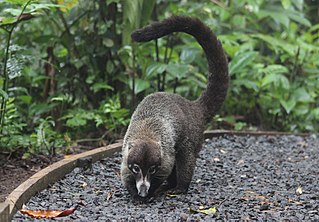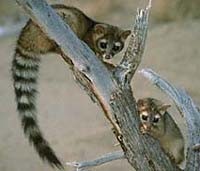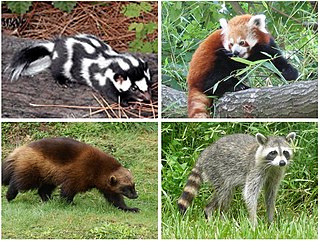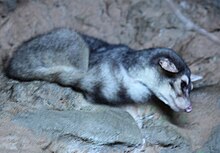
The white-nosed coati, also known as the coatimundi, is a species of coati and a member of the family Procyonidae. Local Spanish names for the species include antoon, gato solo, pizote, and tejón, depending upon the region. It weighs about 4–6 kg (8.8–13.2 lb), and the nose-to-tail length of the species is about 110 cm (3.6 ft) with about half of that being the tail length. However, small females can weigh as little as 3.1 kg (6.8 lb), while large males can weigh as much as 9 kg (20 lb).

Coatis, also known as coatimundis, are members of the family Procyonidae in the genera Nasua and Nasuella. They are diurnal mammals native to South America, Central America, Mexico, and the Southwestern United States. The name "coatimundi" comes from the Tupian languages of Brazil, where it means "lone coati". Locally in Belize, the coati is known as "quash".

The ringtail is a mammal of the raccoon family native to arid regions of North America. It is widely distributed and well adapted to disturbed areas. It has been legally trapped for its fur. It is listed as Least Concern on the IUCN Red List. The species is known by variety of different names, such as ring-tailed cat, miner's cat, civet cat, and cacomistle, though the last of these can refer to B. sumichrasti.

Procyonidae is a New World family of the order Carnivora. It includes the raccoons, ringtails, cacomistles, coatis, kinkajous, olingos, and olinguitos. Procyonids inhabit a wide range of environments and are generally omnivorous.

Procyon is a genus of nocturnal mammals comprising three species commonly known as raccoons in the family Procyonidae. The most familiar species, the common raccoon, is often known simply as "the" raccoon, as the two other raccoon species in the genus are native only to the tropics and less well known. Genetic studies have shown that the closest relatives of raccoons are the ring-tailed cats and cacomistles of genus Bassariscus, from which they diverged about 10 million years ago.

The kinkajou is a tropical rainforest mammal of the family Procyonidae related to olingos, coatis, raccoons, and the ringtail and cacomistle. It is the only member of the genus Potos and is also known as the "honey bear". Kinkajous are arboreal, they are not closely related to any other tree-dwelling mammal group.

Bassariscus is a genus in the family Procyonidae. There are two extant species in the genus: the ringtail or ring-tailed cat and the cacomistle. Genetic studies have indicated that the closest relatives of Bassariscus are raccoons, from which they diverged about 10 million years ago in the Tortonian Age of the Miocene. The two lineages of Bassariscus are thought to have separated after only another two million years, making it the extant procyonid genus with the earliest diversification. Later diversification in the genus in the Pliocene and Pleistocene saw the emergence of two extinct species, Bassariscus casei and Bassariscus sonoitensis, respectively. Due to the more digitigrade stance of their legs compared to the plantigrade stance of other members of Procyonidae, some taxonomies place the genus as a separate family, Bassaricidae.. The name is a Greek word for fox ("bassaris") with a Latinized diminutive ending ("-iscus"). The genus was named by Elliott Coues in 1887, having previously been described by Lichtenstein in 1830 under the name Bassaris. Coues proposed the word "bassarisk" as the English term for animals in this genus. Its habitat includes semi-arid areas in the southwestern United States, the whole of Mexico, as well as moist tropical forests in Central America.

Caniformia is a suborder within the order Carnivora consisting of "dog-like" carnivorans. They include dogs, bears, raccoons, and mustelids. The Pinnipedia are also assigned to this group. The center of diversification for the Caniformia is North America and northern Eurasia. Caniformia stands in contrast to the other suborder of Carnivora, the Feliformia, the center of diversification of which was in Africa and southern Asia.

The wildlife of Costa Rica comprises all naturally occurring animals, fungi and plants that reside in this Central American country. Costa Rica supports an enormous variety of wildlife, due in large part to its geographic position between North and South America, its neotropical climate, and its wide variety of habitats. Costa Rica is home to more than 500,000 species, which represent nearly 5% of the species estimated worldwide, making Costa Rica one of the 20 countries with the highest biodiversity in the world. Of these 500,000 species, a little more than 300,000 are insects.

The northern olingo, also known as the bushy-tailed olingo or, simply, the olingo, is an arboreal (tree-dwelling) member of the raccoon family, Procyonidae, which also includes the coatimundis and kinkajou. Native to Central America, it was the first species of olingo to be scientifically described; while it is considered by some authors to be the only “true” olingo species, a review of the genus Bassaricyon had shown there to be a total of four species, two of those now being considered synonymous with the northern olingo. Its specific name honors William More Gabb (1839-1878), who found and collected the first specimen for western science.

The South American coati, also known as the ring-tailed coati, is a coati species and a member of the raccoon family (Procyonidae), found in the tropical and subtropical parts of South America. An adult generally weighs from 2–7.2 kg (4.4–15.9 lb) and is 85–113 cm (33–44 in) long, with half of that being its tail. Its color is highly variable and the rings on the tail may be only somewhat visible, but its most distinguishing characteristic is that it lacks the largely white snout of its northern relative, the white-nosed coati.

The Cozumel raccoon is a critically endangered species of island raccoon endemic on Cozumel Island off the coast of the Yucatan Peninsula, Mexico. It is sometimes also called the pygmy raccoon, dwarf raccoon, Cozumel Island raccoon, and Cozumel raccoon bear.

Sumichrast's vesper rat is a rodent of the family Cricetidae found from southern Mexico to Panama. It is named for François Sumichrast, the collector of the first specimen, and its closest relative is probably Hatt's vesper rat, a similar, but slightly smaller, species from the Yucatán Peninsula.
Ringtail, ring tail, or ring-tail may refer to:

Musteloidea is a superfamily of carnivoran mammals united by shared characteristics of the skull and teeth. Musteloids are the sister group of pinnipeds, the group which includes seals.

The Veracruz montane forests is a tropical moist broadleaf forest ecoregion in eastern Mexico. It includes a belt of montane tropical forest on the eastern slope of the southern Sierra Madre Oriental and eastern Trans-Mexican Volcanic Belt ranges. These forests lie between the lowland Veracruz moist forests and the pine-oak forests of the higher mountains.

Sierra de los Agustinos is a mountain range in Guanajuato state of central Mexico. The range is a protected natural area, and provides water, firewood, recreation for the surrounding region.



















